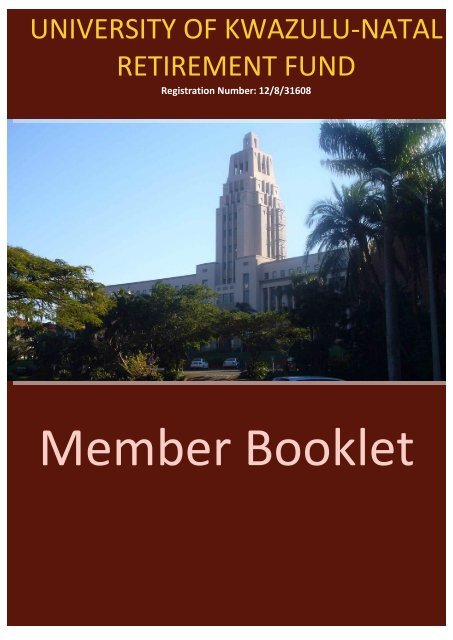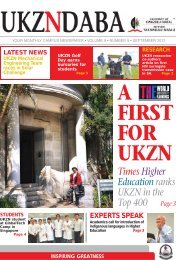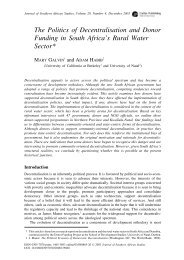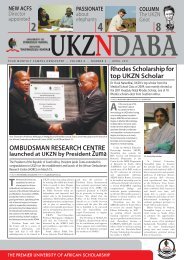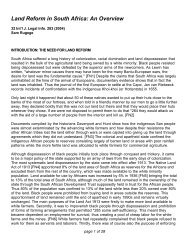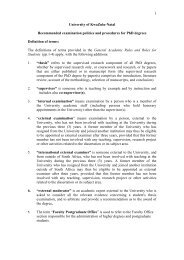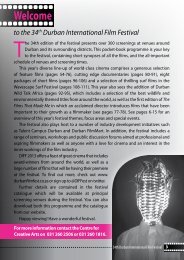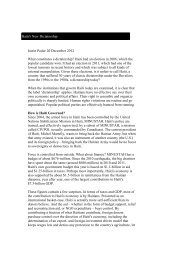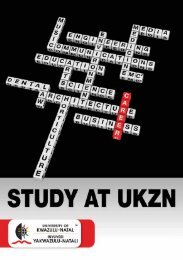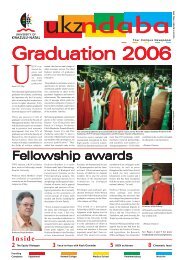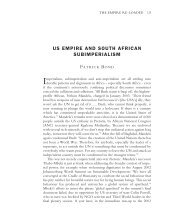Member Booklet - UKZN Retirement Fund - University of KwaZulu ...
Member Booklet - UKZN Retirement Fund - University of KwaZulu ...
Member Booklet - UKZN Retirement Fund - University of KwaZulu ...
Create successful ePaper yourself
Turn your PDF publications into a flip-book with our unique Google optimized e-Paper software.
UNIVERSITY OF KWAZULU-NATAL<br />
RETIREMENT FUND<br />
Registration Number: 12/8/31608<br />
<strong>Member</strong> <strong>Booklet</strong>
UNIVERSITY OF<br />
KWAZULU-NATAL<br />
RETIREMENT FUND<br />
Registration Number: 12/8/31608<br />
Registered Address: <strong>University</strong> <strong>of</strong> <strong>KwaZulu</strong>Natal, 314 Admin Building, Westville Campus,<br />
Westville, 4041<br />
<strong>Member</strong> <strong>Booklet</strong><br />
This booklet sets out both <strong>Fund</strong> benefits and benefits<br />
payable in terms <strong>of</strong> the <strong>UKZN</strong> Benefit Arrangement<br />
NOTE<br />
August 2013<br />
This booklet is not a legal document. It is for information purposes only and does not override the relevant<br />
rules and policies governing the <strong>Fund</strong>, or your conditions <strong>of</strong> service as an employee.<br />
- 1 -
INTRODUCTION<br />
The <strong>University</strong> <strong>of</strong> <strong>KwaZulu</strong>-Natal <strong>Retirement</strong> <strong>Fund</strong><br />
was established on 1st January<br />
1995 as a defined contribution provident fund, to help provide <strong>Fund</strong> members with income during<br />
their retirement years. In conjunction with the <strong>Fund</strong>, the <strong>University</strong> <strong>of</strong> <strong>KwaZulu</strong>-Natal Benefit<br />
provides <strong>Fund</strong> members with death, disability and<br />
funeral benefits.<br />
In South Africa, a state pension is unlikely to provide you with enough money on which to live<br />
comfortably throughout your retirement years. Hence building up capital to fund your retirement is<br />
important. This takes many years <strong>of</strong> saving, which is easier and more tax efficient if done through<br />
a retirement fund.<br />
This booklet sets out details <strong>of</strong> the benefits that members enjoy in terms <strong>of</strong> the rules <strong>of</strong> the <strong>Fund</strong>,<br />
as well as the death, disability and funeral benefits provided by the Benefit Arrangement.<br />
It is important for you to understand the benefits that you and your family can expect to receive<br />
and you can do this by reading this booklet and asking questions about anything you do not<br />
understand. You can access a copy <strong>of</strong> the most up-to-<br />
and its<br />
registered rules by going to http://retirementfund.ukzn.ac.za. If you have questions you can direct<br />
them to the <strong>Fund</strong> Office, the contact details <strong>of</strong> which are set out at the end <strong>of</strong> the booklet.<br />
This booklet is not a legal document and is provided for information purposes only. In the event <strong>of</strong><br />
a conflict, the relevant rules and policies governing the <strong>Fund</strong> and your conditions <strong>of</strong> service as an<br />
employee will apply.<br />
- 2 -
HOW THE FUND WORKS<br />
Every month your employer contributes a percentage <strong>of</strong> your <strong>Fund</strong> Salary to the <strong>Fund</strong> and Benefit<br />
Arrangement. The total <strong>Fund</strong> contribution is paid into the <strong>Fund</strong> and Alexander<br />
Forbes, the current <strong>Fund</strong> Administrator, credits the amount <strong>of</strong> your contribution to your <strong>Fund</strong><br />
Credit.<br />
Your <strong>Fund</strong> Credit is the accumulation <strong>of</strong> these monthly contributions towards retirement funding,<br />
plus any transfers into the <strong>Fund</strong>, any additional voluntary contributions you have made, and the<br />
investment returns generated.<br />
The <strong>Fund</strong> has appointed investment managers which invest the total contributions<br />
behalf, with the intention <strong>of</strong> generating investment returns that will increase their value over time.<br />
Each month the returns that arise from investing your contributions are adjusted on your <strong>Fund</strong><br />
The benefit you receive when you leave service depends on how much was contributed towards<br />
your <strong>Fund</strong> Credit, and how well the F<br />
have performed.<br />
YOUR FUND IS A PROVIDENT FUND<br />
Being a member <strong>of</strong> a provident fund means that when you retire your <strong>Fund</strong> Credit can either be<br />
used to purchase an annuity; or can be take in cash. Your choices and their implications are set<br />
out in Section 4.4.<br />
- 3 -
1. JOINING THE FUND<br />
1.1 MEMBERSHIP<br />
From 1 October 2012 the following categories <strong>of</strong> new employees are eligible for membership.<br />
Anyone eligible for membership is required to join the <strong>Fund</strong>.<br />
a. All new employees appointed to <strong>University</strong> <strong>of</strong> <strong>KwaZulu</strong>-Natal funded permanent posts on<br />
conditions <strong>of</strong> service specifying membership <strong>of</strong> the <strong>Fund</strong>;<br />
b. All new employees appointed to <strong>University</strong> <strong>of</strong> <strong>KwaZulu</strong>-Natal funded posts on fixed-term<br />
contracts specifying membership <strong>of</strong> the <strong>Fund</strong>;<br />
c. Employees employed on permanent or fixed-term contracts by any division <strong>of</strong> the<br />
<strong>University</strong> <strong>of</strong> <strong>KwaZulu</strong>-Natal in posts funded by another body or organisation on<br />
conditions <strong>of</strong> service which specify membership <strong>of</strong> the <strong>Fund</strong>;<br />
d. <strong>Member</strong>s <strong>of</strong> the <strong>Fund</strong> as at 1 October 2012 continue to be members even if they do not fit<br />
any <strong>of</strong> these categories.<br />
1.2 DATE OF JOINING THE FUND<br />
If your employment is from the first day <strong>of</strong> a month, that will be your <strong>Fund</strong> joining date. If you join<br />
during the month, and a pro-rata contribution is paid for that month, your date <strong>of</strong> engagement will<br />
be your joining date.<br />
1.3 WITHDRAWAL FROM THE FUND WHILE EMPLOYED BY THE EMPLOYER<br />
In terms <strong>of</strong> Income Tax regulations, you are obliged to remain a <strong>Fund</strong> member as long as you<br />
continue to be employed by the <strong>University</strong> <strong>of</strong> <strong>KwaZulu</strong>-Natal, or by a body or organisation on<br />
conditions <strong>of</strong> service which specify membership <strong>of</strong> the <strong>Fund</strong>.<br />
- 4 -
2. MANAGEMENT AND GOVERNANCE<br />
2.1 MANAGEMENT<br />
The <strong>Retirement</strong> <strong>Fund</strong> is managed by a Board <strong>of</strong> ten Trustees.<br />
The Trustees meet regularly to discuss the business <strong>of</strong> the <strong>Fund</strong> and are required to act in the<br />
interests <strong>of</strong> the membership. They attend to important matters such as:<br />
- ensuring that benefits due to members are properly paid in accordance with the Rules;<br />
- ensuring that the assets <strong>of</strong> the <strong>Fund</strong> are appropriately invested.<br />
When it is necessary, the Trustees appoint and consult with appropriate pr<strong>of</strong>essional advisers.<br />
If you have a <strong>UKZN</strong> email address, you will be sent an electronic Annual Benefit Statement, which<br />
allows you to monitor your <strong>Fund</strong> Credit. Those members without email addresses will receive a<br />
paper copy <strong>of</strong> their Annual Benefit Statement. It is important that you review this Benefit Statement<br />
when you receive it and if you have any queries, immediately raise them with the <strong>Fund</strong>.<br />
2.2 GOVERNANCE OF THE RETIREMENT FUND<br />
The <strong>Fund</strong> is privately administered and controlled by a Board <strong>of</strong> Trustees. It is administrated<br />
according to Rules that have been registered with the Registrar <strong>of</strong> Pension <strong>Fund</strong>s and approved<br />
by the South African Revenue Service, and the legislation governing retirement funds.<br />
This booklet is issued for information purposes only. The legal position regarding all matters<br />
relating to the <strong>Fund</strong> will be determined in accordance with the registered Rules.<br />
- 5 -
3. CONTRIBUTIONS TO THE FUND<br />
If you are employed on the pre-2012 Conditions <strong>of</strong> Service, your Employer contributes 22.5% <strong>of</strong><br />
your <strong>Fund</strong> Salary each month towards funding your retirement benefit and to meet the cost <strong>of</strong> risk<br />
benefits and administration expenses.<br />
If you are remunerated on a Total Remuneration Package (TRP) basis, you have a choice<br />
between your Employer contributing at 22.5% or 17.5% <strong>of</strong> your <strong>Fund</strong> Salary. The lower<br />
contribution level is only available to members who have set their <strong>Fund</strong> Salary at a level <strong>of</strong><br />
between 70% and 80% <strong>of</strong> their TRP.<br />
Whichever contribution category you have elected, a maximum <strong>of</strong> 5% <strong>of</strong> your <strong>Fund</strong> Salary may be<br />
used to meet the costs <strong>of</strong> death, disability and funeral benefits provided under the Benefit<br />
Arrangement, and the F<br />
contribution is credited to your <strong>Fund</strong> Credit.<br />
In choosing your contribution level remember that contributing at the 17.5% <strong>of</strong> <strong>Fund</strong> Salary<br />
contribution level throughout your membership, will mean that your retirement income could be<br />
25% to 30% lower than if you had contributed at the default 22.5% <strong>of</strong> <strong>Fund</strong> Salary contribution<br />
level. To maximize your retirement income, t<br />
you contribute at the<br />
default level <strong>of</strong> 22.5% <strong>of</strong> <strong>Fund</strong> Salary, and maintain your <strong>Fund</strong> Salary at between 70% and 80% <strong>of</strong><br />
TRP.<br />
A separate document is available on th<br />
that explains this in more detail. When<br />
you are making a packaging choice please ensure that you refer to this document.<br />
If you have not converted to the TRP method <strong>of</strong> payment, your contributions will automatically<br />
remain at the 22.5% <strong>of</strong> <strong>Fund</strong> Salary level.<br />
3.1 FUND SALARY<br />
If you are remunerated on the pre-2012 Conditions <strong>of</strong> Service your <strong>Fund</strong> Salary is your basic<br />
annual salary, together with the cash value <strong>of</strong> any benefits on which the Employer has directed<br />
that the contribution be based, and<br />
your salary advice.<br />
If your employment is based on the Total Remuneration Package basis (TRP), your <strong>Fund</strong> Salary<br />
will be the percentage <strong>of</strong> your TRP, on which you have chosen that you contributions be based.<br />
Your <strong>Fund</strong> Salary can be set at between 55% and 80% <strong>of</strong> your TRP, but clearly the more you pay<br />
into the <strong>Fund</strong>, the more you will get out <strong>of</strong> it.<br />
- 6 -
3.2 FUND CREDIT<br />
Your <strong>Fund</strong> Credit at any particular date is the sum <strong>of</strong>:<br />
(a)<br />
(b)<br />
(c)<br />
The monthly contributions paid into the <strong>Fund</strong> in respect <strong>of</strong> your membership;<br />
Any transfer-in values;<br />
Any Additional Voluntary Contributions you choose to make;<br />
Plus<br />
The net investment returns earned on your contributions by the investment portfolio in which your<br />
<strong>Fund</strong> Credit is invested.<br />
3.3 ADDITIONAL VOLUNTARY CONTRIBUTIONS<br />
From 1 July 2013 members may elect to make additional voluntary contributions to the <strong>Fund</strong>, by<br />
means <strong>of</strong> a payroll deduction. These additional voluntary contributions will form part <strong>of</strong> your <strong>Fund</strong><br />
Credit, and may only be returned to you when you leave service.<br />
These additional voluntary contributions will not qualify for a tax deduction, as member<br />
contributions to a provident are not tax deductible. However, there are no administration fees<br />
deducted from additional contributions, and you will benefit from the fact that the investment fees<br />
charged will be at a lower rate than for individual investments.<br />
Your additional contributions will be invested in the same way as your <strong>Fund</strong> Credit and will be<br />
adjusted monthly by investment returns. To arrange this deduction you must complete the form<br />
obtainable from the Fun it, and forward it to the Payroll<br />
Department. They will then effect the deduction and pay over the amount to the <strong>Fund</strong> monthly. The<br />
total amount paid will be reflected on your annual Benefit Statement.<br />
- 7 -
4. RETIREMENT BENEFITS<br />
4.1 NORMAL RETIREMENT DATE<br />
Your Normal <strong>Retirement</strong> Date is the last day <strong>of</strong> the year in which you<br />
reach age 60, unless a later date is specified in your contract <strong>of</strong><br />
appointment.<br />
4.2 EARLY RETIREMENT<br />
Provided your application for early retirement is approved by the<br />
<strong>University</strong> <strong>of</strong> <strong>KwaZulu</strong>-Natal, you may retire from the <strong>Fund</strong> at any<br />
time after reaching age 55. It is important to remember that if you<br />
retire early, you will have less money saved than if you retired on<br />
your Normal <strong>Retirement</strong> Date, and your <strong>Fund</strong> Credit will have to<br />
generate retirement income for a longer period. It is in your interests<br />
to consult a financial advisor before making this decision.<br />
If at a younger age than 55 you become totally and permanently disabled, you would be entitled to<br />
receive your <strong>Fund</strong> Credit as an early retirement benefit, and would be allowed to claim the same<br />
tax-free portion <strong>of</strong> your benefit as if you had retired at the normal retirement date.<br />
4.3 LATE RETIREMENT<br />
You may only remain a member <strong>of</strong> the <strong>Fund</strong> beyond you Normal <strong>Retirement</strong> Date if your Employer<br />
requests this and issues you with a contact, which states that your <strong>Fund</strong> membership will continue. In<br />
this case you may stay on as a member <strong>of</strong> the <strong>Fund</strong> to a maximum <strong>of</strong> age 70, when you will have to<br />
retire.<br />
4.4 BENEFIT PAYMENT OPTIONS AT RETIREMENT DATE<br />
At your <strong>Retirement</strong> Date, you have the choice <strong>of</strong> your <strong>Fund</strong> Credit being paid as: a) an annuity,<br />
taken out in your own name b) a cash transfer or c) a combination <strong>of</strong> these two options.<br />
Purchasing an annuity at retirement involves entering into an agreement with a Registered Insurer,<br />
to provide you with monthly income (a pension) for life. The amount you receive will depend on the<br />
capital amount you have available at retirement, and the type <strong>of</strong> annuity you decide to purchase.<br />
If you buy an annuity with any portion <strong>of</strong> your <strong>Fund</strong> Credit, you will not pay tax on that portion <strong>of</strong><br />
your retirement benefit at the time <strong>of</strong> your retirement. You will be paid a monthly income by the<br />
insurer from which you purchase the annuity, which will be taxed in the same way your salary is<br />
currently taxed.<br />
You will pay tax on any amount that you decide to take as a cash lump sum, that exceeds the taxfree<br />
portion (R315 000 in 2013, but updated from time to time).<br />
Please refer to Section 9 for the taxation implications <strong>of</strong> taking a cash payment at retirement.<br />
It is important that you obtain advice and consider all the alternatives before deciding on<br />
the payment <strong>of</strong> your retirement benefit.<br />
Transfer to a preservation fund is only available on resignation, retrenchment or dismissal. If you<br />
are retiring from the <strong>University</strong> you may not transfer your lump sum to a preservation fund.<br />
- 8 -
5. DEATH BENEFITS<br />
5.1 DEATH IN SERVICE BEFORE RETIREMENT<br />
While you are a contributing member <strong>of</strong> the <strong>Fund</strong>, the following death benefits are payable to your<br />
dependants and/or nominees upon your death in service:<br />
a) <strong>Fund</strong> Benefit - Your <strong>Fund</strong> Credit, accrues as an annuity and can also be paid in cash.<br />
Beyond the tax free portion, any amount paid in cash is taxable in the same way as a<br />
retirement benefit. (Refer to Section 9 for the details);<br />
and<br />
b) Insured Benefit - An amount equal to 5 x your annual <strong>Fund</strong> Salary is payable from a<br />
group life policy which forms part <strong>of</strong> the Benefit Arrangement. This insured portion will be<br />
paid out without deduction <strong>of</strong> taxation, as fringe benefit taxation on the premiums is<br />
deducted from your salary monthly.<br />
The insured benefit is subject to conditions laid down by the insurer, which may be amended from<br />
time to time. If your insured benefit is greater than the applicable medical free limit, you may be<br />
required to submit a medical report before the insurer accepts the full liability. If this is the case,<br />
the Administrator will let you know the requirements. It is then your responsibility to<br />
arrange for the requested medical testing to be carried out. If you fail to do so, in the event <strong>of</strong> your<br />
death the benefit paid will be lower.<br />
5.2 DISTRIBUTION OF DEATH BENEFITS<br />
In the event <strong>of</strong> your death while in service, the Trustees are required, in terms <strong>of</strong> Section 37(C) <strong>of</strong><br />
the Pension <strong>Fund</strong>s Act and the insurance policy under the <strong>UKZN</strong> Benefit Arrangement, to conduct<br />
a thorough investigation to identify all your dependants and nominated beneficiaries. The<br />
Trustees then have to distribute the benefits according to<br />
dependency.<br />
The Trustees have to determine who your dependants are, then they have to decide who qualifies<br />
for payment, and finally they have to decide how and in what proportions the benefits will be paid.<br />
If you had not recently completed a nomination form and handed it in to your HR Benefits Officer,<br />
or if your family members are difficult to find, the process may be unnecessarily delayed. Hence, it<br />
is important to keep your Nomination <strong>of</strong> Beneficiary form up to date. During 2013 every <strong>Fund</strong><br />
member is required to complete and submit a new form. . If one or more <strong>of</strong> your legal dependants<br />
are financially self-sufficient, you may indicate a nil allocation next to their name.<br />
The Trustees will consider your wishes in reaching their decision, but if you have dependants they<br />
are required by law to follow the process outlined above and their allocation may differ to what you<br />
have indicated. If you have no dependants, the Trustees will distribute your death benefits<br />
according to your Nomination <strong>of</strong> Beneficiary Form.<br />
Please review your nomination forms each time your circumstances change, for example, due to<br />
marriage, divorce, or the birth <strong>of</strong> a child. You can obtain the new Nomination <strong>of</strong> Beneficiary form<br />
from the website, or from your HR Benefits Officer.<br />
- 9 -
6. LEAVING SERVICE<br />
6.1 LEAVING SERVICE BEFORE NORMAL RETIREMENT DATE<br />
(Resignation, Retrenchment or Dismissal)<br />
If you resign, are retrenched, or are dismissed, you will be paid a benefit<br />
equal to your <strong>Fund</strong> Credit at your termination date. If your claim form is<br />
submitted late, the benefit will be calculated as at a later date, taking into<br />
account any market fluctuations between these dates.<br />
Research has shown that only 10% <strong>of</strong> members <strong>of</strong> retirement funds receive<br />
an adequate income after retirement. The main reason for this is that many<br />
members do not preserve their retirement fund benefits when they change<br />
jobs.<br />
On leaving the <strong>Fund</strong> due to resignation, retrenchment or dismissal you can<br />
transfer your retirement savings to:<br />
i) The deferred beneficiary option within the <strong>Fund</strong>;<br />
ii) A preservation fund;<br />
iii) A retirement annuity fund;<br />
iv) Your new employer's pension or provident fund;<br />
OR<br />
v) You can take your retirement savings in cash, after payment <strong>of</strong> any taxation due.<br />
Details <strong>of</strong> these options are set out below:<br />
i) Deferred Beneficiary Option<br />
If you leave the employment <strong>of</strong> the <strong>University</strong> <strong>of</strong> <strong>KwaZulu</strong>-Natal prior to your Normal <strong>Retirement</strong><br />
Date, due to resignation, retrenchment or dismissal, you may choose to become a Deferred<br />
Beneficiary <strong>of</strong> the <strong>Fund</strong>. If you elect this option you will not be able to access your <strong>Fund</strong><br />
Credit before attaining the early retirement age <strong>of</strong> 55.<br />
Following your withdrawal, your <strong>Fund</strong> Credit will be transferred to a special category for former<br />
members. . You will pay no further contributions, and your <strong>Fund</strong> Credit will remain invested in the<br />
Main Portfolios selected by the trustees until age 53. Thereafter you will have the option to switch<br />
to one <strong>of</strong> the pre-retirement portfolios <strong>of</strong>fered by the <strong>Fund</strong>. You may uplift your benefit from the<br />
<strong>Fund</strong> on your retirement, which can be at any time between age 55 and age 70.<br />
In terms <strong>of</strong> the Rules, the <strong>Fund</strong> may charge a fee to administer your <strong>Fund</strong> Credit. Deferred<br />
Beneficiaries are not covered for death, disability and funeral benefits.<br />
Summary <strong>of</strong> Advantages<br />
Your retirement savings are preserved until retirement.<br />
It is a simple process.<br />
No tax is paid at the time <strong>of</strong> your withdrawal.<br />
You can switch investment portfolios once you reach age 53.<br />
You may transfer your benefit to a <strong>Retirement</strong> Annuity <strong>Fund</strong> at a later date.<br />
Summary <strong>of</strong> Disadvantages<br />
You have no access to your <strong>Fund</strong> Credit until you reach age 55.<br />
No extra contributions may be paid.<br />
A fee may be charged to administer your <strong>Fund</strong> Credit.<br />
- 10 -
ii)<br />
Preservation <strong>Fund</strong><br />
A preservation fund is a registered retirement fund designed to preserve and invest your fund<br />
benefits when you leave service until the date you choose to retire. When you transfer your <strong>Fund</strong><br />
Credit to a preservation fund you do not have to pay any tax at the time <strong>of</strong> transfer.<br />
Summary <strong>of</strong> Advantages<br />
Your retirement savings are preserved for retirement.<br />
Normally you will be allowed one withdrawal before retirement, which can be the full amount.<br />
No tax is paid on transfer.<br />
You have full control <strong>of</strong> your retirement savings transferred to the preservation fund, and can<br />
switch investment portfolios from time to time.<br />
A simple nil fee transfer is available to the Alexander Forbes Provident Preservation <strong>Fund</strong>. If<br />
you do not select this option you should enquire from your advisor about any initial fees<br />
payable on transfer <strong>of</strong> your <strong>Fund</strong> Credit.<br />
Summary <strong>of</strong> Disadvantages<br />
You will reduce your retirement benefit if you take advantage <strong>of</strong> the once-<strong>of</strong>f withdrawal<br />
facility.<br />
No extra contributions can be paid into the preservation fund.<br />
Ongoing fees are charged.<br />
iii)<br />
<strong>Retirement</strong> Annuity <strong>Fund</strong>s<br />
If you choose this option, your retirement savings in the <strong>Fund</strong> will be transferred tax-free at the<br />
time <strong>of</strong> transfer to a retirement annuity fund <strong>of</strong> your choice.<br />
Summary <strong>of</strong> Advantages<br />
Your retirement savings are preserved for retirement.<br />
No tax is paid on transfer.<br />
You have control <strong>of</strong> your retirement savings transferred to the preservation fund and can<br />
switch investment portfolios from time to time.<br />
You can make further contributions, which may be tax-deductible up to certain limits.<br />
Summary <strong>of</strong> Disadvantages<br />
You cannot withdraw your <strong>Fund</strong> Credit until age 55.<br />
You may only take up to one-third <strong>of</strong> your retirement savings in cash at retirement. The<br />
balance must be used to buy an annuity from a registered insurer.<br />
Ongoing fees are charged.<br />
iv)<br />
New Employer s <strong>Fund</strong><br />
retirement savings in the <strong>Fund</strong> may be transferred tax-<br />
you choose this option, your<br />
fund.<br />
Summary <strong>of</strong> Advantages<br />
You preserve your retirement savings until retirement<br />
No tax is paid on transfer<br />
There are no costs involved.<br />
Most funds do not charge ongoing fees on amounts transferred in, but you should check on<br />
this aspect with your new employer.<br />
- 11 -
Summary <strong>of</strong> Disadvantages<br />
You may not have any control over the future management <strong>of</strong> your retirement savings.<br />
If you leave your new employer before retirement, you will likely have to transfer your<br />
retirement savings from this employer's fund.<br />
You will not have any access to your retirement savings until you leave the new employer or<br />
retire.<br />
v) Taking Your Benefit as a Cash Payment<br />
This is also an option but it is NOT recommended unless your benefit is<br />
very small. Ideally you should try to preserve your retirement savings for<br />
their real purpose, which is to provide you with a sufficient retirement<br />
benefit. However, for small benefits this is sometimes not practical or cost<br />
effective.<br />
Taxation on any amount in excess <strong>of</strong> R22 500 is payable if you elect the cash option.<br />
(Refer to Section 9. for details)<br />
6.2 DEATH BENEFIT COVER AFTER LEAVING SERVICE<br />
Your 5 x annual <strong>Fund</strong> Salary insured death benefit will cease when you leave service. However,<br />
until age 60 there is an option available to continue cover under an individual insurance policy<br />
in your own name for an amount up to the value <strong>of</strong> your death benefit cover at your date <strong>of</strong><br />
withdrawal. This option is subject to any conditions imposed by the insurer, but you will not have to<br />
provide evidence <strong>of</strong> health (other than an HIV test).<br />
Your application for continuation <strong>of</strong> cover must be made within 30 days <strong>of</strong> your leaving service.<br />
(Details <strong>of</strong> how to apply for this option are set out in an exit document that is available on the<br />
will be supplied to you by Human Resources when you leave the <strong>Fund</strong>).<br />
6.3 TEMPORARY ABSENCE<br />
In the event that you take unpaid leave you will be advised<br />
Division <strong>of</strong> your options. These are to either maintain your risk and retirement benefits at your own<br />
cost, or to temporarily stop these benefit.<br />
If your unpaid leave period exceeds one year, you are required to make application to the Trustees<br />
to continue your membership. This must be done prior to expiry <strong>of</strong> the first year <strong>of</strong> unpaid leave.<br />
If you choose to cease paying all contributions for the purpose <strong>of</strong> the risk benefits, you will<br />
be treated as a new member when you return to service. Hence, you will be subject to the<br />
usual pre-existing conditions clause with regards to disability benefits.<br />
- 12 -
7. DISABILITY BENEFIT<br />
DISABILITY WHILE IN SERVICE BEFORE RETIREMENT<br />
(i)<br />
Monthly Disability Benefit<br />
If, before reaching your Normal <strong>Retirement</strong> Date you become<br />
disabled due to illness or an accident, and are assessed as being<br />
unable to perform the work <strong>of</strong> your own occupation, or any other<br />
reasonable occupation for the <strong>University</strong>, for which you are suited<br />
or could reasonably be expected to become qualified, you will be<br />
regarded as being temporarily disabled and will qualify for a<br />
monthly disability benefit. After a three month waiting period, during<br />
which the <strong>University</strong> maintains payments from your sick leave, a<br />
monthly benefit equal to your full <strong>Fund</strong> Salary may be payable by the Benefit Arrangement for as<br />
long as you are considered disabled. The maximum period for payment <strong>of</strong> a monthly disability<br />
benefit is 21 months. During this period you will be required to submit periodic medical<br />
assessments.<br />
While you are in receipt <strong>of</strong> a monthly disability payment your membership <strong>of</strong> the <strong>Fund</strong> will<br />
continue, and contributions will be paid to the <strong>Fund</strong> on your behalf.<br />
The monthly disability benefit will be subject to tax in the same way as your salary. If you are still<br />
disabled at the end <strong>of</strong> 21 month period, your monthly disability payments will cease and<br />
you will be evaluated by the insurer for payment <strong>of</strong> a total and permanent disability benefit.<br />
If you die while you are receiving a monthly disability benefit, the lump sums described in Section<br />
5 and Section 9 will become payable.<br />
(ii)<br />
Lump Sum Disability Benefit<br />
Two years, from when you first became unable to work, you will be assessed by the insurer for a<br />
total and permanent disability benefit. If you are found by the insurer to be so disabled that you are<br />
unable to perform the work <strong>of</strong> your own or any other occupation, your <strong>Fund</strong> membership will cease<br />
and a lump sum benefit will be paid, to a maximum <strong>of</strong>:<br />
3 x annual <strong>Fund</strong> Salary at the date <strong>of</strong> your disablement,<br />
PLUS<br />
Your <strong>Fund</strong> Credit, which will be subject to tax as a retirement benefit.<br />
(Refer to Section 9. for more details)<br />
Should you become disabled between ages 55 and 60, the 3 x Annual Salary benefit will be<br />
reduced by 20% for each year or part there<strong>of</strong> that the onset <strong>of</strong> your disability precedes your<br />
attaining age 60. The lump sum disability benefit ceases at age 60.<br />
If at this stage you are found by the insurer not to be totally and permanently disabled, and you are<br />
still not able to return to work, your case will be referred to the<br />
Division for evaluation.<br />
- 13 -
8. FUNERAL BENEFIT<br />
8.1 AUTOMATIC FUNERAL COVER<br />
If a member <strong>of</strong> the <strong>University</strong> <strong>of</strong> <strong>KwaZulu</strong>-Natal <strong>Retirement</strong> <strong>Fund</strong> and Benefit Arrangement dies<br />
while in employment, a lump sum funeral benefit <strong>of</strong> R20 000 is paid by the Benefit Arrangement. If<br />
their spouse or a dependent child dies while they are still a <strong>Fund</strong> member, a funeral benefit is also<br />
paid.<br />
Since 1 August 2013 the funeral benefit has been insured. All funeral benefit payments are subject<br />
to the terms <strong>of</strong> the insurance policy in place at the time, the most relevant details <strong>of</strong> which are set<br />
out for your information. A copy <strong>of</strong> the full policy will be made available<br />
Amount <strong>of</strong> the Funeral Benefit<br />
R 20,000 is paid if you or your spouse dies.<br />
If a dependent child dies, the amount paid depends on the child's age, as follows:<br />
R 20,000<br />
R 20,000<br />
R 10,000<br />
R 6,670<br />
R 3,335<br />
is paid for dependent children between ages 22 and 26, provided pro<strong>of</strong> <strong>of</strong><br />
registration <strong>of</strong> such children as full time students at a recognised school or<br />
tertiary institution is provided (previous maximum age was 23)<br />
is paid for children aged between 14 and 22 years (previous maximum age<br />
was 18)<br />
is paid for children aged between 6 and 13 years<br />
is paid for children aged between 1 and 5 years<br />
is paid for children under 1 year (including stillborn babies after 26 weeks)<br />
A child who is permanently incapacitated may qualify for a funeral benefit at any age, subject to<br />
certain conditions.<br />
A maximum <strong>of</strong> eight dependent children are covered under the policy. If you have more than eight<br />
dependent children as set out above, please notify the <strong>Fund</strong> Office.<br />
Dependent Children<br />
Dependent children who are registered on your <strong>UKZN</strong> staff medical aid scheme will<br />
automatically be covered for funeral benefits if they are under age 22.<br />
If you are not a member <strong>of</strong> an <strong>UKZN</strong> staff medical scheme, you must provide a certified copy <strong>of</strong><br />
your medical aid membership card and complete, sign and submit a Funeral Nomination Form.<br />
If you have dependent children who are not covered under your medical aid, you are required<br />
to complete and sign a Funeral Nomination Form. Please attach copies <strong>of</strong> the birth certificates or<br />
identification documents for all your dependent children.<br />
A Funeral Nomination Form can be obtained<br />
http://retirementfund.ukzn.ac.za. Please send the original, completed and signed Funeral Benefit<br />
Nomination Form and supporting documents to the <strong>UKZN</strong> <strong>Retirement</strong> <strong>Fund</strong> Office, Room 314<br />
Administration Building, Westville Campus. Scanned documents and faxes are not accepted.<br />
Definition <strong>of</strong> Spouse in the Policy<br />
Your spouse is taken to be a party to a marriage recognised in terms <strong>of</strong> either the Recognition <strong>of</strong><br />
Customary Marriages Act, 1998 or the Civil Union Act, 2006, or to a union accepted as a marriage<br />
according to the doctrines <strong>of</strong> Asiatic religion.<br />
- 14 -
A person who lives with you in a relationship <strong>of</strong> mutual dependency as if married, may be<br />
covered under the policy as your spouse, but you must submit a Funeral Nomination Form<br />
reflecting them as your life partner, and supply a copy <strong>of</strong> their identification document.<br />
A maximum <strong>of</strong> two spouses may be covered under the policy.<br />
Funeral Claims<br />
In the event <strong>of</strong> the death <strong>of</strong> your spouse or children covered under the policy, you must complete<br />
the Funeral Claim form, and attach all the required documents specified on the form. Claims must<br />
be sent to your Human Resources Benefits Officer, who will confirm that the documents you<br />
have attached are in order before they forward the claim to Alexander Forbes.<br />
Claims must be lodged within six months <strong>of</strong> the date <strong>of</strong> a death, and will be paid within 72 hours<br />
<strong>of</strong> a valid claim form, with all the necessary supporting documents, being provided to Alexander<br />
Forbes.<br />
http://retirementfund.ukzn.ac.za.<br />
Fringe Benefit Taxation<br />
The premium for the funeral benefit will be paid by the <strong>UKZN</strong> Benefit Arrangement. As this is an<br />
employer sponsored scheme, you are liable for fringe benefit taxation on the premium. The<br />
amount will vary according to your income level but will be minimal. It will show on your payslip as<br />
a deduction.<br />
8.2 EXTENDED FAMILY COVER<br />
You may also take out Extended Family Cover at your own cost for:<br />
Your own parents<br />
Your parents-in-law<br />
Your brother or sister<br />
A relative through blood or marriage, who is financially dependent upon you for the<br />
payment <strong>of</strong> their funeral costs<br />
Your dependent child who is over age 22 (or age 26, if in full time education), provided that<br />
you add them when their cover under the main funeral policy ceases.<br />
Please note that your family members must be under age 75 at the time that Extended Family<br />
cover is taken out.<br />
The premium for R20 000 funeral cover depends on the age <strong>of</strong> the family member you wish to<br />
insure. The monthly premiums for the 2013 year are as follows:<br />
R11.10 for family members aged 18 to 64<br />
R33.40 for family members aged 65 to74<br />
R78.00 for family members over age 75 years (Note: they must be under 75 when they are<br />
added to the policy).<br />
Premium rates will be reviewed annually from 1 January 2015. You will be advised <strong>of</strong> any changes<br />
in the premium rate and your stop order will be automatically adjusted for the premium change.<br />
- 15 -
It is your responsibility to adjust your stop order amount when your extended family member<br />
reaches age 65 or age 75, and if you fail to do so it could invalidate the cover.<br />
Since this is voluntary cover, in the six months following your first premium, claims will<br />
only be paid if the death <strong>of</strong> your family member is due to an accident. Thereafter, claims will<br />
be paid for all causes <strong>of</strong> death, unless the death occurs within twelve months <strong>of</strong> your enrolling the<br />
family member and is due to<br />
- Involvement in criminal activities,<br />
- Suicide,<br />
- Self-inflicted injury, or,<br />
- Deliberate exposure to exceptional danger, except in an attempt by the deceased to<br />
save a human life.<br />
To arrange Extended Family Cover for a family member you must complete a Funeral Nomination<br />
http://retirementfund.ukzn.ac.za, with copies <strong>of</strong> IDs<br />
attached, and a Payroll Stop Order form and send them both to the <strong>Fund</strong> Office.<br />
On the form you must provide both your full family details, and full details <strong>of</strong> the additional family<br />
member/s you wish to cover. Cover will only commence once the insurer has received your first<br />
monthly payment, so you should check on your payslip that the stop order has been implemented<br />
and follow up with the Payroll Division if it has not.<br />
You may make changes to the persons on cover if you wish, but if you stop paying the premium<br />
for an Extended Family <strong>Member</strong>, they may not later be readmitted for cover.<br />
Extended Funeral Cover Claims<br />
http://retirementfund.ukzn.ac.za. In the event <strong>of</strong> the death <strong>of</strong> someone covered under the<br />
Extended Family Cover policy, you must complete a Funeral Claim form, and attach all the<br />
required documents specified on the form. Claims must be sent to Shamilla Smith <strong>of</strong> Alexander<br />
Forbes on 031 573 8269 or email smiths1@aforbes.co.za.<br />
Claims must be lodged within six months <strong>of</strong> the date <strong>of</strong> a death, and they will be paid within 72<br />
hours <strong>of</strong> a valid claim form, with all the necessary supporting documents, being provided to<br />
Alexander Forbes.<br />
- 16 -
9. TAXATION OF BENEFITS<br />
(PLEASE NOTE THAT THE FOLLOWING IS BASED ON PREVAILING TAX LEGISLATION<br />
AND IS SUBJECT TO CHANGE)<br />
The benefits payable on retirement, withdrawal, death and disability are subject to tax, as follows:<br />
9.1 RETIREMENT BENEFITS<br />
Your original transfer value (if any) from the AIPF (Associated Institutions Pensions<br />
<strong>Fund</strong>) and any additional voluntary contributions you have made to the <strong>Fund</strong> will be<br />
paid without deduction <strong>of</strong> tax.<br />
The sum <strong>of</strong>:<br />
(a)<br />
the investment earnings on the transfer value (if any),<br />
PLUS<br />
(b)<br />
the balance <strong>of</strong> your <strong>Fund</strong> Credit, will be taxed as follows:<br />
Taxable amount<br />
Rate <strong>of</strong> tax<br />
The first R315,000 0%<br />
Amount exceeding R315,000 but not<br />
exceeding R630,000<br />
Amount exceeding R630,000 but not<br />
exceeding R945,000<br />
Amount exceeding R945,000<br />
18% <strong>of</strong> the taxable amount exceeding<br />
R315,000<br />
R56,700 plus 27% <strong>of</strong> the taxable<br />
amount exceeding R630,000<br />
R141 750 plus 36% <strong>of</strong> the taxable<br />
amount exceeding R945,000<br />
For purposes <strong>of</strong> calculating the tax-free amount, all benefits arising from pension, provident or<br />
retirement annuity funds <strong>of</strong> which you may be or have been a member are taken into account, as<br />
well as any accumulated leave that is paid to you as a tax free gratuity on your retirement.<br />
9.2 WITHDRAWAL<br />
Your original transfer value (if any) from the AIPF and any additional voluntary contributions you<br />
have made to the <strong>Fund</strong> will be refunded without deduction <strong>of</strong> tax.<br />
The balance <strong>of</strong> your withdrawal benefit will be taxed as follows:<br />
Taxable amount<br />
Rate <strong>of</strong> tax<br />
Up to R22,500 0%<br />
Amount exceeding R22,500 but not<br />
exceeding R600,000<br />
Amount exceeding R600,000 but not<br />
exceeding R900,000<br />
Amount exceeding R900,000<br />
18% <strong>of</strong> the taxable amount exceeding<br />
R22,500<br />
R103,950 plus 27% <strong>of</strong> the taxable<br />
amount exceeding R600,000<br />
R184,950 plus 36% <strong>of</strong> the taxable<br />
amount exceeding R900,000<br />
- 17 -
9.3 DEATH BENEFITS<br />
The death benefit has two components:<br />
1) Your <strong>Fund</strong> Credit, on which tax is calculated using the same formula as for retirement. The<br />
tax scale set out in Section 9.1 above will be applied.<br />
2) An Insured Lump Sum Benefit, which is not taxable at time <strong>of</strong> payment.<br />
9.4 DISABILITY BENEFITS<br />
(i)<br />
INCOME DISABILITY BENEFIT<br />
The monthly income disability income benefit is paid for a maximum period <strong>of</strong> 21 months and is<br />
taxed as income in the same way as your salary.<br />
(ii)<br />
LUMP SUM DISABILITY BENEFIT<br />
In the event <strong>of</strong> your being found to be totally and permanently disabled, a lump sum disability<br />
benefit will be paid by the insurer without deduction <strong>of</strong> tax.<br />
In this case your <strong>Fund</strong> Credit will be paid by the <strong>Fund</strong> as an ill-health retirement benefit and the tax<br />
scale set out in Section 9.1 above will be applied.<br />
- 18 -
10.<br />
If you have a normal career progression over thirty years and at least 17.5% <strong>of</strong> your <strong>Fund</strong> Salary<br />
has been contributed towards retirement funding during that time (this is based on a total<br />
contribution rate <strong>of</strong> 22.5% <strong>of</strong> <strong>Fund</strong> Salary), the <strong>Fund</strong> currently aims to provide you with a Net<br />
Replacement Ratio (NRR) <strong>of</strong> at least 65% <strong>of</strong> your Final <strong>Fund</strong> Salary.<br />
Your Net Replacement Ratio (NRR) is the retirement income that you can expect to receive,<br />
shown as a percentage <strong>of</strong> your final <strong>Fund</strong> Salary. It can be worked out by dividing your income at<br />
retirement date by your <strong>Fund</strong> Salary immediately before you retire, and expressing it as a<br />
percentage. A NRR <strong>of</strong> 65% indicates an initial retirement income <strong>of</strong> about two thirds <strong>of</strong> your <strong>Fund</strong><br />
Salary prior to retirement.<br />
10.1 PORTFOLIO STRUCTURE<br />
Contributions for members who are under 53 years <strong>of</strong> age are automatically invested in<br />
Main Portfolio. When you are within seven years <strong>of</strong> normal retirement you are given a choice<br />
about how you would like your <strong>Fund</strong> Credit to be invested.<br />
Main Portfolio<br />
The Main Portfolio is currently invested with two asset managers with investment styles that<br />
complement one another. In terms <strong>of</strong> mandates given by the <strong>Fund</strong>, the managers are allowed to<br />
vary the proportions invested locally and <strong>of</strong>fshore, and within asset classes (i.e. Shares, Bonds,<br />
Property, Cash etc.) within defined limits and subject to the limitations <strong>of</strong> Regulation 28 <strong>of</strong> the<br />
Pensions <strong>Fund</strong> Act. This Regulation governs the investments <strong>of</strong> all retirement funds.<br />
In terms <strong>of</strong> their mandates, the asset managers are permitted to adopt fairly aggressive investment<br />
positions if they see value in doing so, so short-term losses are possible. If you are within seven<br />
years <strong>of</strong> retirement, you have the option <strong>of</strong> transferring to portfolios where short-term losses are<br />
less likely.<br />
The Alexander Forbes Lifestage Range<br />
When you are within seven years <strong>of</strong> your retirement age, you may choose to either leave your<br />
<strong>Fund</strong> Credit in the Main Portfolio or to transfer your <strong>Fund</strong> Credit to one or more <strong>of</strong> the Alexander<br />
Forbes Lifestage portfolios. These portfolios are managed by Investment Solutions. You can<br />
either select your own portfolios or opt to follow one <strong>of</strong> the Alexander Forbes Lifestage Model<br />
(AFLM), which will automatically adjust your investment portfolios depending on the number <strong>of</strong><br />
years you have remaining to your Normal <strong>Retirement</strong> Date.<br />
Once you turn 53, instead <strong>of</strong> leaving your <strong>Fund</strong> Credit in the Main Portfolio, you may<br />
choose to invest in any <strong>of</strong> the following portfolios.<br />
Alexander Forbes High Growth<br />
Pre-<strong>Retirement</strong> Options available<br />
Alexander Forbes High/Medium Growth<br />
to members aged 53 and older:<br />
Alexander Forbes Medium Growth<br />
Alexander Forbes Medium/Conservative Growth<br />
Alexander Forbes Conservative Growth<br />
Pre-<strong>Retirement</strong> Options available Inflation Linked Bond Channel<br />
to members aged 55 and older: Purchasing Power Channel<br />
- 19 -
It is important to<br />
obtain appropriate<br />
financial advice before selecting an alternative portfolio, as the timing <strong>of</strong> your decision and the<br />
portfolio chosen can have a large impact on your eventual retirement income.<br />
Capital Preservation Portfolio and Money Market Portfolios (Closed)<br />
Prior to 2011, members who were within five years <strong>of</strong> their Normal <strong>Retirement</strong> Date, could transfer<br />
(part <strong>of</strong>) their assets to the Fullvest Guaranteed portfolio and those who were within two years <strong>of</strong><br />
their Normal <strong>Retirement</strong> Date could transfer part <strong>of</strong> their assets to the Money Market portfolio. This<br />
option is no longer available, but the <strong>Fund</strong> Credits <strong>of</strong> members already invested will remain in<br />
these portfolios until they retire.<br />
10.2 PORTFOLIO AND MANAGER SELECTION<br />
The <strong>Fund</strong><br />
asset managers are:<br />
Main Portfolio<br />
Pre-<strong>Retirement</strong> Options available to<br />
members aged 53 and older:<br />
Capital Preservation- Closed to new<br />
transfers<br />
Money Market- Closed to new<br />
transfers<br />
Foord Asset Management<br />
Allan Gray Asset Management<br />
Investment Solutions<br />
Investment Solutions<br />
Investec Asset Managers<br />
The trustees consider the following factors when selecting the<br />
asset managers:<br />
Investment process adopted<br />
People employed<br />
Reputation, including past performance and management skills<br />
Total value <strong>of</strong> assets under management<br />
Past returns<br />
Fees and other costs<br />
- 20 -
11. THE PENSION FUNDS ADJUDICATOR AND COMPLAINTS<br />
The Pension <strong>Fund</strong>s Adjudicator deals with complaints relating to the administration <strong>of</strong> funds, the<br />
investment <strong>of</strong> assets or the interpretation and application <strong>of</strong> a fund s rules.<br />
If you have a complaint relating to the administration <strong>of</strong> the <strong>Fund</strong>, before you approach the<br />
Adjudicator you must first lodge the complaint in writing at the<br />
addressed to:<br />
The Principal Officer<br />
<strong>University</strong> <strong>of</strong> <strong>KwaZulu</strong>-Natal <strong>Retirement</strong> <strong>Fund</strong> Office,<br />
314 Administration Building<br />
Westville Campus<br />
Westville 4041.<br />
You may also lodge a complaint with your Employer if your complaint relates to something that has<br />
been done, or has not been done by your Employer relative to your <strong>Fund</strong> membership. If you do<br />
this, please also lodge a copy <strong>of</strong> your complaint with the <strong>Fund</strong>.<br />
The <strong>Fund</strong> or your Employer must reply to you within 30 days. If you are satisfied with their reply,<br />
that is the end <strong>of</strong> the matter. If the <strong>Fund</strong> or Employer does not reply, or if you are not satisfied with<br />
the reply, you may refer your complaint to the Adjudicator.<br />
determination and advise the parties <strong>of</strong> the outcome.<br />
- 21 -
12. THE RULES<br />
Every retirement fund must, by law, be run according to applicable legislation and a set <strong>of</strong> rules<br />
registered by the Registrar <strong>of</strong> Pension <strong>Fund</strong>s and the Financial Services Board. The operations <strong>of</strong><br />
the <strong>Fund</strong> are described in detail in these rules and the <strong>Fund</strong> is run in strict accordance with them.<br />
In a simple booklet such as this, it is not possible to give all these details, but we have tried to<br />
make this guide as accurate and understandable as possible. In case <strong>of</strong> any differences between<br />
this guide and the rules, the rules will apply. If there is a dispute, the dispute resolution mechanism<br />
detailed in the rules <strong>of</strong> the <strong>Fund</strong> will apply.<br />
A copy <strong>of</strong> the rules and the financial statements are available .<br />
<strong>Member</strong>s who do not have access to the internet may view a copy at the <strong>Fund</strong> Office:<br />
314 Administration Building,<br />
Westville Campus,<br />
<strong>University</strong> <strong>of</strong> <strong>KwaZulu</strong>-<br />
Westville,<br />
4041.<br />
<strong>University</strong> <strong>of</strong> <strong>KwaZulu</strong>-Natal <strong>Retirement</strong> <strong>Fund</strong><br />
Reference Number: 12/8/31608<br />
13. NEED TO KNOW MORE<br />
It is very important for you, as a member <strong>of</strong> the <strong>Fund</strong>, to understand the benefits that are available<br />
to you. We have tried to make this guide as understandable as possible. If, after reading through<br />
this guide, there are matters that require further explanation, or if you have any questions about<br />
the <strong>Fund</strong>, you should send your enquiry to the <strong>Fund</strong> at lessing@ukzn.ac.za, or call X1007 for<br />
assistance.<br />
- 22 -


